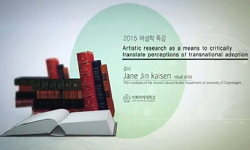This study explores Korean EFL learners’ perceptions of quantification and their grammatical sensitivity in the use of count/mass nouns. To investigate the perceptions of adult learners and young learners, it compared the perceptions of thirty child...
http://chineseinput.net/에서 pinyin(병음)방식으로 중국어를 변환할 수 있습니다.
변환된 중국어를 복사하여 사용하시면 됩니다.
- 中文 을 입력하시려면 zhongwen을 입력하시고 space를누르시면됩니다.
- 北京 을 입력하시려면 beijing을 입력하시고 space를 누르시면 됩니다.
https://www.riss.kr/link?id=A103979485
- 저자
- 발행기관
- 학술지명
- 권호사항
-
발행연도
2014
-
작성언어
English
- 주제어
-
등재정보
KCI등재
-
자료형태
학술저널
-
수록면
463-481(19쪽)
-
KCI 피인용횟수
0
- DOI식별코드
- 제공처
- 소장기관
-
0
상세조회 -
0
다운로드
부가정보
다국어 초록 (Multilingual Abstract)
This study explores Korean EFL learners’ perceptions of quantification and their grammatical sensitivity in the use of count/mass nouns. To investigate the perceptions of adult learners and young learners, it compared the perceptions of thirty children with those of thirty adults using a quantity judgment task. For the adult group, a grammaticality judgment task was additionally administered to investigate their actual use of count/mass nouns. The findings show that both the young and adult learners exhibit a consistent pattern in their perceptions of count/mass nouns giving support to the results obtained in studies which addressed the same topic with learners of different L1 and L2 backgrounds. In the grammaticality judgment task, the adult participants judged the grammaticality of count nouns and subject mass nouns appropriately. They showed a tendency to judge quantity based on numbers for the object mass nouns and the flexible nouns. These results imply that the adult participants’ use of count/mass nouns match their perceptions of count/mass distinction.
참고문헌 (Reference)
1 Quine, W. V. O., "Word and object" MIT Press 1960
2 Chierchia, G., "Syntactic theory and first language acquisition: Cross-linguistic perspectives" Lawrence Erlbaum 1994
3 Middleton, E. L., "Separating the chaff from the oats: Evidence for a conceptual distinction between count noun and mass noun aggregates" 50 (50): 371-394, 2004
4 Bloom, P., "Semantic structure and language development" Massachusetts Institute of Technology 1990
5 Yuko Yamashita, "Second language and cognition: Conceptual categorization of count/mass nouns in English with Japanese university students" 13 (13): 363-390, 2011
6 Neal Snape, "Resetting the nominal mapping parameter in L2 English: Definite article use and the count-mass distinction" 11 (11): 63-79, 2008
7 Chierchia, G., "Reference to kinds across languages" 6 : 339-405, 1998
8 Barner, D, "Quantity judgments and individuation: evidence that mass nouns count" 97 : 41-66, 2005
9 Bloom, P., "Possible individuals in language and cognition" 5 (5): 90-94, 1996
10 Chierchia, G., "Plurality of mass nouns and the notion of “semantic parameter,”" 70 : 53-103, 1998
1 Quine, W. V. O., "Word and object" MIT Press 1960
2 Chierchia, G., "Syntactic theory and first language acquisition: Cross-linguistic perspectives" Lawrence Erlbaum 1994
3 Middleton, E. L., "Separating the chaff from the oats: Evidence for a conceptual distinction between count noun and mass noun aggregates" 50 (50): 371-394, 2004
4 Bloom, P., "Semantic structure and language development" Massachusetts Institute of Technology 1990
5 Yuko Yamashita, "Second language and cognition: Conceptual categorization of count/mass nouns in English with Japanese university students" 13 (13): 363-390, 2011
6 Neal Snape, "Resetting the nominal mapping parameter in L2 English: Definite article use and the count-mass distinction" 11 (11): 63-79, 2008
7 Chierchia, G., "Reference to kinds across languages" 6 : 339-405, 1998
8 Barner, D, "Quantity judgments and individuation: evidence that mass nouns count" 97 : 41-66, 2005
9 Bloom, P., "Possible individuals in language and cognition" 5 (5): 90-94, 1996
10 Chierchia, G., "Plurality of mass nouns and the notion of “semantic parameter,”" 70 : 53-103, 1998
11 Wisniewski, E. J., "On the equivalence of superordinate concepts" 60 : 269-298, 1996
12 Nemoto, N., "On mass denotations of bare nouns in Japanese and Korean" 43 (43): 383-413, 2005
13 Gathercole, V., "More and more and more about more" 40 : 73-104, 1985
14 Inagaki, S, "Lexical and syntactic sources of individuation: Evidence from quantity judgment in Japanese and English" International Christian University 2006
15 Whorf B. L., "Language, thought, and reality" MIT Press 1956
16 Inagaki, S, "Countability in absence of count syntax: Evidence from Japanese quantity judgments" 8 : 111-125, 2009
17 Hua, D, "Chinese ESL learners’ understanding of the English count-mass distinction" Shanghai International Studies University and Hunan University 2005
동일학술지(권/호) 다른 논문
-
- 21세기영어영문학회
- 김성철 ( Sung Chul Kim )
- 2014
- KCI등재
-
영국 디아스포라 사회에 나타난 오리엔탈리즘 -하니프 쿠레이쉬의 『도시 교외의 부처』를 중심으로
- 21세기영어영문학회
- 김연정 ( Yeon Jeong Kim )
- 2014
- KCI등재
-
돈 드릴로의 『화이트 노이즈』에 제시된 포스트모던 경험의 속성
- 21세기영어영문학회
- 나희경 ( Hee Kyung Nah )
- 2014
- KCI등재
-
우연, 디스토피아 그리고 영제국의 운명 -세기말 소설의 불안감에 대한 진화론적 해석
- 21세기영어영문학회
- 문상화 ( Sang Wha Moon )
- 2014
- KCI등재
분석정보
인용정보 인용지수 설명보기
학술지 이력
| 연월일 | 이력구분 | 이력상세 | 등재구분 |
|---|---|---|---|
| 2024 | 평가예정 | 재인증평가 신청대상 (재인증) | |
| 2021-01-01 | 평가 | 등재학술지 선정 (계속평가) |  |
| 2020-12-01 | 평가 | 등재후보로 하락 (재인증) |  |
| 2017-01-01 | 평가 | 등재학술지 유지 (계속평가) |  |
| 2013-01-01 | 평가 | 등재학술지 유지 (등재유지) |  |
| 2010-01-01 | 평가 | 등재학술지 선정 (등재후보2차) |  |
| 2009-01-01 | 평가 | 등재후보 1차 PASS (등재후보1차) |  |
| 2007-01-01 | 평가 | 등재후보학술지 선정 (신규평가) |  |
| 2005-06-29 | 학회명변경 | 한글명 : 21영어영문학회 -> 21세기영어영문학회 |
학술지 인용정보
| 기준연도 | WOS-KCI 통합IF(2년) | KCIF(2년) | KCIF(3년) |
|---|---|---|---|
| 2016 | 0.25 | 0.25 | 0.25 |
| KCIF(4년) | KCIF(5년) | 중심성지수(3년) | 즉시성지수 |
| 0.26 | 0.25 | 0.49 | 0.07 |




 KCI
KCI




